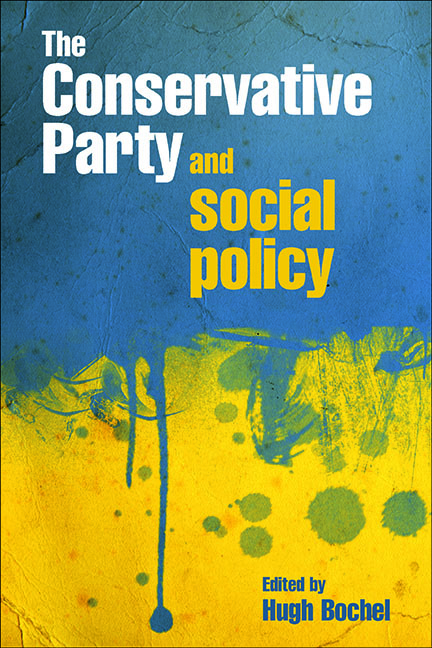Book contents
- Frontmatter
- Contents
- Notes on contributors
- one Conservative approaches to social policy since 1997
- two The Conservative Party and the welfare state since 1945
- three The Conservative Party and public expenditure
- four The Conservatives, social policy and public opinion
- five Conservative health policy: change, continuity and policy influence
- six Something old, something new: understanding Conservative education policy
- seven Conservative housing policy
- eight Social security and welfare reform
- nine A new welfare settlement? The Coalition government and welfare-to-work
- ten The Conservative Party and community care
- eleven Conservative policy and the family
- twelve Crime and criminal justice
- thirteen The Conservatives and social policy in the devolved administrations
- fourteen The Conservatives and the governance of social policy
- fifteen The Conservatives, Coalition and social policy
- References
two - The Conservative Party and the welfare state since 1945
Published online by Cambridge University Press: 01 September 2022
- Frontmatter
- Contents
- Notes on contributors
- one Conservative approaches to social policy since 1997
- two The Conservative Party and the welfare state since 1945
- three The Conservative Party and public expenditure
- four The Conservatives, social policy and public opinion
- five Conservative health policy: change, continuity and policy influence
- six Something old, something new: understanding Conservative education policy
- seven Conservative housing policy
- eight Social security and welfare reform
- nine A new welfare settlement? The Coalition government and welfare-to-work
- ten The Conservative Party and community care
- eleven Conservative policy and the family
- twelve Crime and criminal justice
- thirteen The Conservatives and social policy in the devolved administrations
- fourteen The Conservatives and the governance of social policy
- fifteen The Conservatives, Coalition and social policy
- References
Summary
‘Vote for change’, the Conservatives’ (ultimately highly prescient) campaign slogan for the 2010 general election, appears at first sight to be an unlikely catchphrase for a party that has historically been associated with order, tradition, hierarchy and institutional arrangements that have stood the test of time. However, this embrace of change becomes more understandable when one recognises that the party’s longevity and unparalleled electoral success has resulted from its willingness to modify both its principles and policies in the light of new circumstances. As Rodney Lowe (2005, p 25) remarks, echoing the influential 18th-century philosopher Edmund Burke, traditional Conservative philosophy is based on ‘conserving what is best in the old while adapting constantly to the new’. One of the consequences of this ‘adaptive’ mindset is that it can lead to the charge that the party has no settled convictions or principled policy prescriptions (Green, 2002). During the course of their history the Conservatives have, as Marquand (2010, p 24) observes,
changed sides – sometimes more than once – on virtually all the great questions dividing the political nation. They have been for protection and for free trade, for fiscal orthodoxy and for Keynesian economics, for local democracy and for relentless centralisation, for appeasing Hitler and for resisting him, for entry into the European Community and for keeping Europe at arm's length.
The thorny question of what the Conservative Party stands for will be explored briefly in the opening section of this chapter. This discussion will form the backdrop to a three-part examination of the Conservative approach to the welfare state. Attention will be focused first on the emergence and development of modern One Nation Conservatism from the end of the war until the demise of the Douglas-Home government in 1964. Second, the neo-liberal turn in the Conservative approach to the welfare state, which surfaced briefly in the early years of the Heath government and came to fruition during the Thatcher (1979–90) and Major (1990–97) eras, will be considered. Third, David Cameron's ‘progressive’ Conservative approach to social welfare will be explored. The concluding section of the chapter will consider whether a common thread can be detected in the Conservative approach to the welfare state since the Second World War.
- Type
- Chapter
- Information
- The Conservative Party and Social Policy , pp. 23 - 40Publisher: Bristol University PressPrint publication year: 2011



